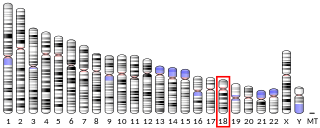
Magnesium is an essential element in biological systems. Magnesium occurs typically as the Mg2+ ion. It is an essential mineral nutrient (i.e., element) for life and is present in every cell type in every organism. For example, adenosine triphosphate (ATP), the main source of energy in cells, must bind to a magnesium ion in order to be biologically active. What is called ATP is often actually Mg-ATP. As such, magnesium plays a role in the stability of all polyphosphate compounds in the cells, including those associated with the synthesis of DNA and RNA.

The bacterial outer membrane is found in gram-negative bacteria. Its composition is distinct from that of the inner cytoplasmic cell membrane - among other things, the outer leaflet of the outer membrane of many gram-negative bacteria includes a complex lipopolysaccharide whose lipid portion acts as an endotoxin - and in some bacteria such as E. coli it is linked to the cell's peptidoglycan by Braun's lipoprotein.
Magnesium transporters are proteins that transport magnesium across the cell membrane. All forms of life require magnesium, yet the molecular mechanisms of Mg2+ uptake from the environment and the distribution of this vital element within the organism are only slowly being elucidated.

Sphingomyelin phosphodiesterase is a hydrolase enzyme that is involved in sphingolipid metabolism reactions. SMase is a member of the DNase I superfamily of enzymes and is responsible for breaking sphingomyelin (SM) down into phosphocholine and ceramide. The activation of SMase has been suggested as a major route for the production of ceramide in response to cellular stresses.
In molecular biology, the electroneutral cation-Cl family of proteins are a family of solute carrier proteins. This family includes the products of the Human genes: SLC12A1, SLC12A1, SLC12A2, SLC12A3, SLC12A4, SLC12A5, SLC12A6, SLC12A7, SLC12A8 and SLC12A9.

In enzymology, a protein-glutamate O-methyltransferase is an enzyme that catalyzes the chemical reaction
In enzymology, a fatty-acyl-CoA-transporting ATPase (EC 7.6.2.4) is an enzyme that catalyzes the chemical reaction
In enzymology, a maltose-transporting ATPase (EC 3.6.3.19) is an enzyme that catalyzes the chemical reaction
In enzymology, a Mg2+-importing ATPase (EC 3.6.3.2) is an enzyme that catalyzes the chemical reaction
In enzymology, an oligopeptide-transporting ATPase (EC 3.6.3.23) is an enzyme that catalyzes the chemical reaction
In enzymology, a phosphate-transporting ATPase (EC 3.6.3.27) is an enzyme that catalyzes the chemical reaction
In enzymology, a polar-amino-acid-transporting ATPase (EC 3.6.3.21) is an enzyme that catalyzes the chemical reaction
In enzymology, an adenosylcobinamide kinase is an enzyme that catalyzes the chemical reaction

In enzymology, an adenosylcobinamide-phosphate guanylyltransferase is an enzyme that catalyzes the chemical reaction

Guanine nucleotide-binding protein G(z) subunit alpha is a protein that in humans is encoded by the GNAZ gene.

Urea transporter 1 is a protein that in humans is encoded by the SLC14A1 gene.

Rh family, C glycoprotein, also known as RHCG, is a protein that in humans is encoded by the RHCG gene.

Conserved oligomeric Golgi complex subunit 5 is a protein that in humans is encoded by the COG5 gene.

Organic solute transporter alpha, also known as OST-alpha, is a protein which in humans is encoded by the SLC51A gene.

Magnesium transporters E (MgtE) are a family of transmembrane eubacterial MgtE magnesium transporters. Related regions are found also in archaeal and eukaryotic proteins. They have sizes that vary considerably from 311 residues for the Methanococcus thermoautotrophicum protein, 463 residues for a Synechocystis homologue, and 513 residues for the human homologue, SLC41A1. These proteins are capable of transporting Mg2+ and Co2+ but not Ni2+. Multiple alignments contain two highly conserved aspartates that may be involved in cation binding.











